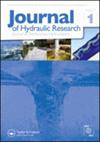粗床明渠的流动发展:平均速度、湍流统计、速度谱和二次流
IF 1.7
3区 工程技术
Q3 ENGINEERING, CIVIL
引用次数: 4
摘要
在设计水工结构或规划明渠研究实验时,从河道入口到完全建立,水流发展所需的河道长度通常是先决条件。然而,关于流量发展长度()的信息很少,甚至其定义也很模糊。在水力学实验中,这种知识的缺乏带来了很大的不确定性,经常使不同研究结果的比较变得可疑。本文提供了一个基于物理学的定义,并报告了系统实验室研究的结果,为其定量评估提供了指导。我们的均匀流数据表明,平均速度场(包括侧壁二次流)、湍流应力(顺流变化除外)、速度偏斜度和峰度以及深度尺度的大尺度运动需要高达100个流动深度(),才能基本上独立于顺流坐标。然而,发现非常大尺度的运动、流向速度变化和粗糙度引起的二次流需要更长的时间。本文章由计算机程序翻译,如有差异,请以英文原文为准。
Flow development in rough-bed open channels: mean velocities, turbulence statistics, velocity spectra, and secondary currents
The channel length required for the development of the flow, from the channel entrance to full establishment, is often a prerequisite when designing hydraulic structures or planning research experiments in open channels. However, the information on the flow development length ( ) is scarce, and even its definition remains vague. In hydraulic experiments, this lack of knowledge introduces great uncertainty, often making comparisons of findings from different studies questionable. This paper offers a physics-based definition for , and reports results of systematic laboratory studies to provide guidance on its quantitative assessment. Our data for uniform flows suggest that up to 100 flow depths ( ) are required for mean velocity field (including sidewall secondary currents), turbulent stresses (except streamwise variance), velocity skewness and kurtosis, and depth-scale large-scale-motions to become essentially independent of the streamwise coordinate. However, very large-scale-motions, streamwise velocity variance, and roughness-induced secondary currents are found to require longer of around .
求助全文
通过发布文献求助,成功后即可免费获取论文全文。
去求助
来源期刊

Journal of Hydraulic Research
工程技术-工程:土木
CiteScore
4.90
自引率
4.30%
发文量
55
审稿时长
6.6 months
期刊介绍:
The Journal of Hydraulic Research (JHR) is the flagship journal of the International Association for Hydro-Environment Engineering and Research (IAHR). It publishes research papers in theoretical, experimental and computational hydraulics and fluid mechanics, particularly relating to rivers, lakes, estuaries, coasts, constructed waterways, and some internal flows such as pipe flows. To reflect current tendencies in water research, outcomes of interdisciplinary hydro-environment studies with a strong fluid mechanical component are especially invited. Although the preference is given to the fundamental issues, the papers focusing on important unconventional or emerging applications of broad interest are also welcome.
 求助内容:
求助内容: 应助结果提醒方式:
应助结果提醒方式:


